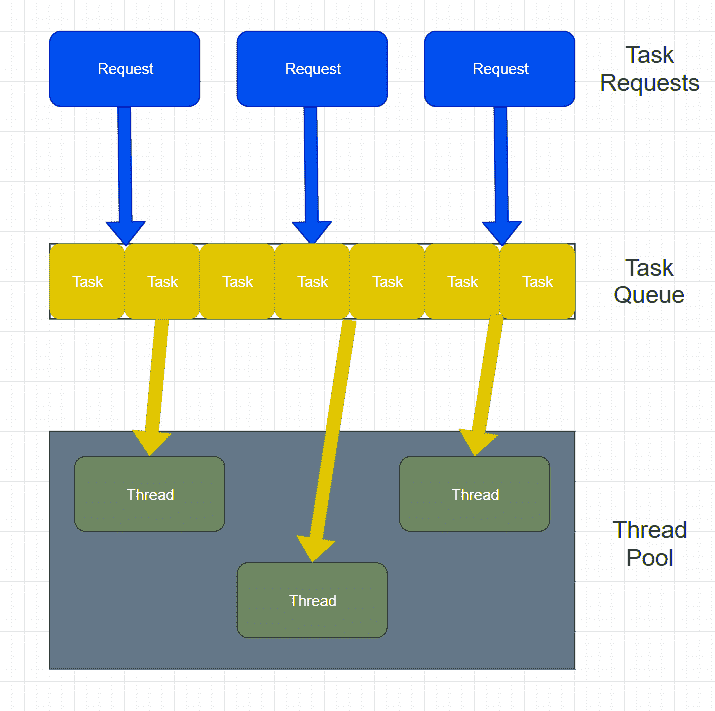# Java 線程池示例
> 原文: [https://javatutorial.net/java-thread-pool-example](https://javatutorial.net/java-thread-pool-example)
活動線程消耗系統資源,這可能導致 [JVM](https://javatutorial.net/jvm-explained) 創建太多線程,這意味著系統將很快用盡內存。

這就是 Java 中的線程池有助于解決的問題。
## 線程池如何工作?
線程池將先前創建的線程重用于當前任務。 這就解決了需要太多線程的問題,因此內存不足不是一個選擇。 您甚至可以將線程池??視為回收系統。 它不僅消除了用盡內存的選項,而且還使應用程序非常快速地響應,因為當請求到達時已經存在一個線程。

上圖的工作流不僅可以控制應用程序正在創建的線程數,還可以控制計劃任務的執行并將傳入的任務保持在隊列中。
## `Executor`,`Runnable`和`ExecutorService`
Java 提供了`Executor`框架,這意味著您只需要實現`Runnable`對象并將其發送給執行器即可執行。
要使用線程池,首先我們需要創建一個`ExecutorService`對象并將任務傳遞給它。`ThreadPoolExecutor`類設置核心和最大池大小。 然后,可運行對象將順序執行。
## 不同的`Executor`線程池方法
```java
newFixedThreadPool(int size) - creates a fixed size thread pool
newCachedThreadPool() - creates a thread pool that creates new threads if needed but will also use previous threads if they are available
newSingleThreadExecutor() - creates a single thread
```
`ExecutorService`接口包含許多方法,這些方法用于控制任務的進度并管理服務的終止。 您可以使用`Future`實例控制任務的執行。 有關如何使用`Future`的示例:
```java
ExecutorService execService = Executors.newFixedThreadPool(6);
Future<String> future = execService.submit(() -> "Example");
String result = future.get();
```
`ThreadPoolExecutor`使您可以實現具有許多參數的可擴展線程池,這些參數包括`corePoolSize`,`maximumPoolSize`,`keepAliveTime`,`unit`,`workQueue`,`handler`,`threadFactor`。 但是,`corePoolSize`,`maximumPoolSize`和`keepAliveTime`是主要變量,因為它們在每個構造函數中都使用。
`corePoolSize`是要保留在池中的線??程數,即使它們處于空閑狀態,除非設置了`allowCoreThreadTimeOut`。
`maximumPoolSize`是池中允許的最大線程數。
`keepAliveTime`是當線程數大于內核數時,這是多余的空閑線程將在終止之前等待新任務的最長時間。
有關其他參數的更多信息,請訪問[原始 Oracle 文檔](https://docs.oracle.com/javase/7/docs/api/java/util/concurrent/ThreadPoolExecutor.html)。
## 線程池實現示例
工作流程步驟:
1. 創建要執行的任務
2. 使用執行程序創建執行程序池
3. 將任務傳遞給執行程序池
4. 關閉執行程序池
`Task.java`
```java
import java.text.SimpleDateFormat;
import java.util.Date;
import java.util.concurrent.ExecutorService;
import java.util.concurrent.Executors;
// (Step 1)
public class Task implements Runnable {
private String name;
public Task(String name) {
this.name = name;
}
public void run() {
try {
for (int i = 0; i < 5; i++) {
if (i == 1) {
Date date = new Date();
SimpleDateFormat ft = new SimpleDateFormat("hh:mm:ss");
System.out.println("Time initialization for task " + this.name + " is " + ft.format(date));
}
else {
Date date = new Date();
SimpleDateFormat ft = new SimpleDateFormat("hh:mm:ss");
System.out.println("Execution time for task " + this.name + " is " + ft.format(date));
}
Thread.sleep(1000);
}
}
catch(InterruptedException error) {
error.printStackTrace();
}
System.out.println(this.name + " completed");
}
}
```
`Main.java`
```java
import java.text.SimpleDateFormat;
import java.util.Date;
import java.util.concurrent.ExecutorService;
import java.util.concurrent.Executors;
public class Main {
public static void main(String[] args) {
Runnable task1 = new Task("task 1");
Runnable task2 = new Task("task 2");
Runnable task3 = new Task("task 3");
Runnable task4 = new Task("task 4");
Runnable task5 = new Task("task 5");
// (Step 2)
ExecutorService pool = Executors.newFixedThreadPool(3);
// (Step 3)
pool.execute(task1);
pool.execute(task2);
pool.execute(task3);
pool.execute(task4);
pool.execute(task5);
// (Step 4)
pool.shutdown();
}
}
```
**輸出**:
```java
Time initialization for task task 2 is 10:18:40
Time initialization for task task 1 is 10:18:40
Time initialization for task task 3 is 10:18:40
Execution time for task task 3 is 10:18:41
Execution time for task task 1 is 10:18:41
Execution time for task task 2 is 10:18:41
Execution time for task task 2 is 10:18:42
Execution time for task task 3 is 10:18:42
Execution time for task task 1 is 10:18:42
Execution time for task task 1 is 10:18:43
Execution time for task task 3 is 10:18:43
Execution time for task task 2 is 10:18:43
Execution time for task task 3 is 10:18:44
Execution time for task task 1 is 10:18:44
Execution time for task task 2 is 10:18:44
task 2 completed
task 1 completed
task 3 completed
Time initialization for task task 4 is 10:18:45
Time initialization for task task 5 is 10:18:45
Execution time for task task 4 is 10:18:46
Execution time for task task 5 is 10:18:46
Execution time for task task 4 is 10:18:47
Execution time for task task 5 is 10:18:47
Execution time for task task 5 is 10:18:48
Execution time for task task 4 is 10:18:48
Execution time for task task 4 is 10:18:49
Execution time for task task 5 is 10:18:49
task 4 completed
task 5 completed
```
**上面的代碼實現的細分**:
`Task.java`表示任務類。 每個任務都有一個名稱實例變量,并且每個任務都使用構造函數實例化。 此類有 1 個方法,稱為`run`。 在`run`方法的主體內,有一個`for`循環,該循環根據存在的任務數進行迭代。 在我們的例子中,有 5 個任務,這意味著它將運行 5 次。 第一次迭代,顯示當前任務初始化的時間。 其他迭代,打印執行時間。 打印完成后,有一個`Thread.sleep()`方法調用,該方法用于以 1 秒的延遲顯示每個迭代消息。 **注意**,像這樣調用的方法名稱`run`非常重要,因為它是來自`Task`類正在實現的`Runnable`的抽象方法。
僅在池中的某個胎面變得空閑時才執行任務 4 和 5。 在此之前,額外的任務將放置在隊列中。
執行完所有任務后,請關閉線程池。
## 線程池何時有用
組織服務器應用程序時。 如本文開頭所述,在組織服務器應用程序時非常有用,因為使用線程池非常有效,就像有許多任務一樣,它會自動將它們放入隊列中。 不僅如此,它還可以防止內存不足,或者至少可以顯著減慢這樣做的速度。 使用`ExecutorService`使其更易于實現。
- JavaTutorialNetwork 中文系列教程
- Java 基礎
- Java 概述
- 在 Ubuntu 上安裝 Java 8 JDK
- Java Eclipse 教程
- Eclipse 快捷方式
- 簡單的 Java 示例
- Java 基本類型
- Java 循環
- Java 數組
- Java 讀取文件示例
- Java 對象和類教程
- 什么是面向對象編程(OOP)
- Java 封裝示例
- Java 接口示例
- Java 繼承示例
- Java 抽象示例
- Java 多態示例
- Java 中的方法重載與方法覆蓋
- Java 控制流語句
- Java 核心
- 如何在 Windows,Linux 和 Mac 上安裝 Maven
- 如何使用 Maven 配置文件
- 如何將自定義庫包含到 Maven 本地存儲庫中
- 如何使用 JUnit 進行單元測試
- 如何使用 Maven 運行 JUnit 測試
- 如何在 Java 中使用 Maven 創建子模塊
- 如何使用 Maven 創建 Java JAR 文件
- 如何使用 Maven 創建 Java WAR 文件
- JVM 解釋
- Java 內存模型解釋示例
- 捕獲 Java 堆轉儲的前 3 種方法
- Java 垃圾收集
- Java 互斥量示例
- Java 信號量示例
- Java 并行流示例
- Java 線程同步
- Java 線程池示例
- Java ThreadLocal示例
- Java 中的活鎖和死鎖
- Java Future示例
- Java equals()方法示例
- Java Lambda 表達式教程
- Java Optional示例
- Java 11 HTTP 客戶端示例
- Java 類加載器介紹
- Java 枚舉示例
- Java hashCode()方法示例
- 如何測試獨立的 Java 應用程序
- SWING JFrame基礎知識,如何創建JFrame
- Java SWING JFrame布局示例
- 在JFrame上顯示文本和圖形
- 與JFrame交互 – 按鈕,監聽器和文本區域
- 如何使用 Maven 創建 Java JAR 文件
- Java Collection新手指南
- 選擇合適的 Java 集合
- Java ArrayList示例
- Java LinkedList示例
- Java HashSet示例
- Java TreeSet示例
- Java LinkedHashSet示例
- Java EnumSet示例
- Java ConcurrentHashSet示例
- Java HashMap示例
- Java LinkedHashMap示例
- Java TreeMap示例
- Java EnumMap示例
- Java WeakHashMap示例
- Java IdentityHashMap示例
- Java SortedMap示例
- Java ConcurrentMap示例
- Java Hashtable示例
- Java 中ArrayList和LinkedList之間的區別
- Java HashMap迭代示例
- Java HashMap內聯初始化
- Java 中HashMap和TreeMap之間的區別
- Java 圖示例
- Java 深度優先搜索示例
- Java 廣度優先搜索示例
- 不同的算法時間復雜度
- Java 序列化示例
- Java 反射示例
- Java 中的弱引用
- Java 8 日期時間 API
- Java 基本正則表達式
- 使用 Java 檢索可用磁盤空間
- Java 生成 MD5 哈希和
- Java 增加內存
- Java 屬性文件示例
- 如何在 Eclipse 上安裝 Java 9 Beta
- Java 9 JShell 示例
- Java 9 不可變列表示例
- Java 9 不可變集示例
- Java 9 不可變映射示例
- Java 單例設計模式示例
- Java 代理設計模式示例
- Java 觀察者設計模式示例
- Java 工廠設計模式
- Java 構建器設計模式
- Java 比較器示例
- Java 發送電子郵件示例
- Java volatile示例
- Java Docker 和 Docker 容器簡介
- 安裝和配置 MySQL 數據庫和服務器以供 Spring 使用
- 如何在 Java 中使用 MySQL 連接器
- 如何使用 Eclipse 調試 Java
- Java EE
- 如何在 Windows 10 中設置JAVA_HOME
- JavaBeans 及其組件簡介
- 如何安裝和配置 Tomcat 8
- 如何在 Tomcat 中部署和取消部署應用程序
- 從 Eclipse 運行 Tomcat
- Java Servlet 示例
- Java Servlet POST 示例
- Servlet 請求信息示例
- Servlet 注解示例
- 使用初始化參數配置 Java Web 應用程序
- Java Servlet 文件上傳
- Java JSP 示例
- Glassfish 啟用安全管理
- 如何使用 MySQL 配置 Glassfish 4
- Java 文件上傳 REST 服務
- Glassfish 和 Jetty 的 Java WebSockets 教程
- 基于 Glassfish 表單的身份驗證示例
- 如何使用 Java EE 和 Angular 構建單頁應用程序
- Spring
- 在 Eclipse 中安裝 Spring STS
- 使用 STS 創建簡單的 Spring Web App
- Spring Web Framework 簡介
- Java Docker 和 Docker 容器簡介
- 在 Spring 中實現控制器
- Spring 中的PathVariable注解
- Spring 中的RequestBody注解
- Spring 中的RequestParam注解
- Spring 攔截器
- Spring IOC
- Java Spring IoC 容器示例
- Spring 中的DispatcherServlet
- Spring 示例中的依賴注入
- 實現 Spring MVC 控制器
- Spring ORM 簡介
- 什么是 DAO 以及如何使用它
- 如何對 DAO 組件進行單元測試
- 如何對控制器和服務執行單元測試
- 安裝和配置 MySQL 數據庫和服務器以供 Spring 使用
- 如何在 Spring 中處理登錄身份驗證
- Spring Security 簡介及其設置
- 如何使用 Spring 創建 RESTful Web 服務
- Spring CSRF 保護
- Spring 中基于 OAuth2 的身份驗證和授權
- Spring Boot 簡介
- Spring MVC 框架介紹
- Spring JDBC 簡介
- 如何 docker 化 Spring 應用程序
- Spring 的@Autowired注解
- Spring AOP 中的核心概念和建議類型
- Sping Bean 簡介
- 如何在 Java 中使用 MySQL 連接器
- 安卓
- 安裝和配置 Android Studio
- 將 Android 設備連接到 Android Studio
- Android 簡介,活動,意圖,服務,布局
- 創建一個簡單的 Android 應用
- 運行和調試 Android 應用程序
- 在虛擬設備上運行 Android 應用程序
- Android 活動示例
- Android 意圖示例
- Android 服務示例
- Android 線性布局示例
- Android 相對布局示例
- Android Web 視圖示例
- Android 列表視圖示例
- Android 網格視圖示例
- 帶有ListAdapter的 Android ListView示例
- Android SQLite 數據庫介紹
- Android SQLite 數據庫示例
- Android 動畫教程
- Android 中的通知
- Android 中的事件處理
- 如何在 Android 中發送帶有附件的電子郵件
- 雜項
- 選擇您的 JAVA IDE:Eclipse,NetBeans 和 IntelliJ IDEA
- Java S3 示例
- 如何在 Ubuntu 上為多個站點配置 Apache
- 如何在 Liferay DXP 中替代現成的(OOTB)模塊
- 簡單的 Git 教程
- 使用 Java 捕獲網絡數據包
- Selenium Java 教程
- 使用特定工作區運行 Eclipse
- 在 Eclipse 中安裝 SVN
- 如何運行 NodeJS 服務器
- SQL 內連接示例
- SQL 左連接示例
- SQL 右連接示例
- SQL 外連接示例
- 樹莓派
- Raspberry Pi 3 規格
- 將 Raspbian 安裝到 SD 卡
- Raspberry Pi 首次啟動
- 遠程連接到 Raspberry Pi
- 建立 Raspberry Pi 遠程桌面連接
- Raspberry Pi Java 教程
- 使用 PWM 的 Raspberry Pi LED 亮度調節
- Raspberry Pi 控制電機速度
- Raspberry Pi 用 Java 控制直流電機的速度和方向
